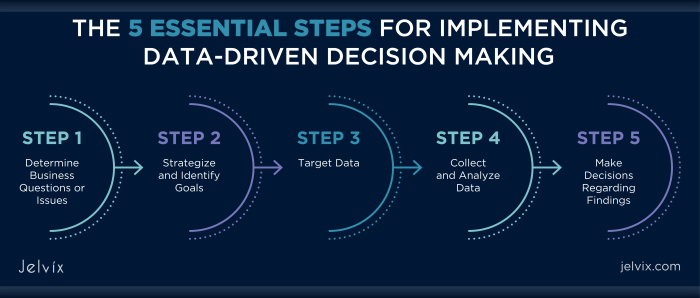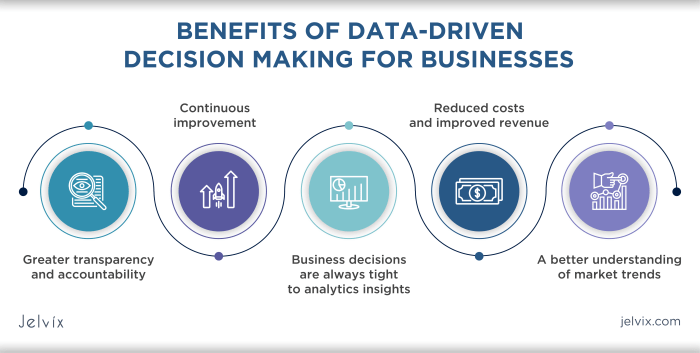Data-Driven Decision Making sets the stage for smart choices in a data-driven world. It’s like navigating high school hallways armed with the coolest insights and trends to rule the game.
From defining the concept to exploring its benefits and implementation, this topic unveils the power of data in shaping impactful decisions.
Definition of Data-Driven Decision Making

Data-driven decision making refers to the process of making informed choices based on data analysis and interpretation rather than relying solely on intuition or personal experience. It involves collecting, analyzing, and leveraging data to guide decision-making processes across various industries.
Examples of Data-Driven Decision Making
- In the retail industry, companies use sales data to determine which products are popular among customers and adjust their inventory accordingly.
- In healthcare, medical professionals analyze patient data to develop personalized treatment plans and improve patient outcomes.
- In marketing, businesses use data from social media platforms to target specific demographics with tailored advertising campaigns.
The Importance of Data-Driven Decision Making
- Data-driven decision making allows businesses to identify trends, patterns, and opportunities that may not be apparent through traditional methods.
- It helps organizations optimize processes, improve efficiency, and stay competitive in today’s rapidly evolving market.
- By relying on data rather than gut feelings, companies can make more accurate predictions and reduce the risk of costly errors.
Benefits of Data-Driven Decision Making

Data-driven decision making offers numerous advantages in various aspects of business and decision-making processes. By utilizing data to inform choices, organizations can make more informed, strategic decisions that lead to improved outcomes and overall success.
Improved Accuracy and Precision
One of the key benefits of data-driven decision making is the ability to enhance accuracy and precision in decision-making processes. By analyzing relevant data sets and metrics, organizations can reduce errors and make more precise decisions based on factual information rather than intuition or guesswork.
Enhanced Performance and Efficiency
Data-driven decision making can lead to enhanced performance and efficiency within organizations. By leveraging data analytics and insights, companies can identify areas for improvement, optimize processes, and streamline operations to achieve better results in a more streamlined manner.
Strategic Planning and Forecasting
Another advantage of data-driven decision making is the ability to engage in strategic planning and forecasting with greater confidence. By analyzing historical data trends and predictive analytics, organizations can anticipate future outcomes, risks, and opportunities, allowing for proactive decision-making and strategic initiatives.
Competitive Advantage
Utilizing data to drive decision making provides organizations with a competitive advantage in the marketplace. By making informed, data-backed decisions, companies can stay ahead of the competition, adapt to changing market conditions, and capitalize on emerging trends to drive innovation and growth.
Real-Time Insights and Adaptability
Data-driven decision making enables organizations to access real-time insights and adapt to changing circumstances quickly. By monitoring key metrics and performance indicators, companies can make agile, data-driven decisions that respond to immediate challenges and opportunities, ensuring ongoing success and resilience.
Implementing Data-Driven Decision Making
Implementing a data-driven decision-making strategy involves several key steps to ensure successful integration within an organization.
Establish Clear Objectives and Goals
- Define specific objectives and goals that align with the organization’s overall mission and vision.
- Ensure that these objectives are measurable and can be tracked using relevant data.
Collect Relevant Data
- Identify the types of data needed to support decision-making processes.
- Implement systems and tools to collect, store, and analyze data effectively.
Ensure Data Quality, Data-Driven Decision Making
- Verify the accuracy, completeness, and reliability of the data being used.
- Implement data validation processes to maintain data integrity.
Utilize Data Analysis Techniques
- Apply statistical analysis, data mining, and machine learning to extract insights from the data.
- Use visualization tools to communicate findings and trends effectively.
Make Data-Driven Decisions
- Empower decision-makers with the necessary tools and training to leverage data effectively.
- Encourage a culture of data-driven decision-making throughout the organization.
Tips for Transitioning to Data-Driven Decision Making
- Start small and focus on specific projects or departments to pilot the implementation.
- Involve key stakeholders and departments in the process to gain buy-in and support.
- Provide ongoing training and support to ensure staff are comfortable with using data in decision-making.
Challenges and How to Overcome Them
- Resistance to change: Address concerns and misunderstandings through communication and education.
- Data silos: Break down barriers between departments to improve data sharing and integration.
- Lack of expertise: Invest in training and hiring data experts to support the implementation process.
Tools and Technologies for Data-Driven Decision Making
In the realm of data-driven decision making, various tools and technologies play a crucial role in collecting, analyzing, and interpreting data to derive valuable insights that drive informed decisions.
Popular Tools and Technologies
- 1. Microsoft Excel: Widely used for data organization, analysis, and visualization.
- 2. Tableau: Helps in creating interactive and shareable dashboards for data visualization.
- 3. Google Analytics: Used for tracking website traffic and user behavior.
- 4. Python and R: Programming languages commonly used for data analysis and statistical modeling.
Role of Tools in Decision Making
These tools aid in making informed decisions by providing the following benefits:
- 1. Data collection: Tools help in gathering data from various sources to ensure comprehensive analysis.
- 2. Data analysis: Tools enable users to analyze large datasets efficiently and identify patterns or trends.
- 3. Data visualization: Tools help in presenting data in a visually appealing manner for better understanding.
- 4. Real-time insights: Tools provide real-time data analytics, allowing for quick decision-making based on up-to-date information.
Role of AI and Machine Learning
The integration of AI and machine learning algorithms further enhances data-driven decision making by:
- 1. Predictive analytics: AI algorithms can predict future outcomes based on historical data, aiding in proactive decision-making.
- 2. Pattern recognition: Machine learning algorithms can identify complex patterns in data that may not be apparent to human analysts.
- 3. Personalization: AI can help personalize recommendations and decisions based on individual preferences and behavior.
